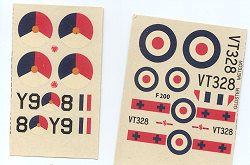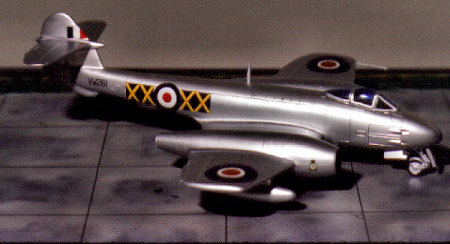
| KIT: | Frog 1/72 Meteor IV |
| KIT #: | F 200 |
| PRICE: | $ |
| DECALS: | Two options |
| REVIEWER: | Scott Van Aken |
| NOTES: |

| HISTORY |
Britain's first operational jet fighter was the Gloster Meteor, a twin engine fighter with four 20mm cannon as the main armament. Though it only saw brief action in the last months of the war, and never scored an air to air victory against German aircraft, it went on to a wide range of variants and many years of service.
The first post-war variant was the Meteor F.4, a variant that saw quite a bit of export success and was the first jet of a number of air forces. To many, it was one of the most appealing looking of the Meteor family, though I'm sure the F.8 crowd will not totally agree.
| THE KIT |
 Frog's kit of the Meteor F.4 has been a favorite of fans for many years, even past the demise of Frog in 1976. Fortunately for us all, Novo of the then Soviet Union bought all the non-German aircraft molds and so the kit was still regularly available for those who had to have it. The decals in those Novo kits were either quite poor or non-existent, but the aftermarket decal crowd was able to provide a number of options to keep us happy.
Frog's kit of the Meteor F.4 has been a favorite of fans for many years, even past the demise of Frog in 1976. Fortunately for us all, Novo of the then Soviet Union bought all the non-German aircraft molds and so the kit was still regularly available for those who had to have it. The decals in those Novo kits were either quite poor or non-existent, but the aftermarket decal crowd was able to provide a number of options to keep us happy.
The kit itself is quite basic, but also quite nicely molded with raised detailing. Mine is molded in a very dark blue plastic and the previous owner had already pared away a number of parts from the sprues, but the kit is complete (aside from the stand which, when this was boxed, was available separately).
The cockpit consists of a floor, seat, stick and pilot. At the time, the detail level of the pilot's office was not considered a priority so most kits had quite Spartan interiors. Wheel wells are not boxed in for the main gear and quite shallow for the nose gear. No indication of weight is given but you will need to pack in a considerable amount to keep it on its nose. A blanking plate is provided for the engine fronts with the exhaust remaining open. The only real options are fuel tanks. One for the lower fuselage and a pair for beneath the wings. Holes for the latter are already drilled out on the lower wings. A once piece canopy that is rather thick is provided.
Despite the age of the kit, mine is in very good condition. I did find sink areas on the wheels and opposite alignment pins on the lower wings. The latter will be easy to fix, but not so the ones on the wheels. I'd recommend some Aeroclub replacement gear to take care of the latter situation.
Instructions are typical Frog in that they are well done and provide no interior or well color information. In fact, no color information is given at all aside from the overall aluminum recommendation of the decal placement guide on the bottom of the box. Markings are given for two aircraft. One is a Dutch aircraft from 323 squadron as shown on the box art. The other is from 263 squadron, RAF, both in overall aluminum. I do believe that this color was lacquer paint and not unpainted metal. For some reason, the previous owner cut the decal sheet in half. The old sheet had also curled up into nearly a cylinder in the 30 years or more since the kit was produced. That's why the rather odd juxtaposition shown.
| CONCLUSIONS |
Overall, this is a very nice kit. It provides an excellent starting place for the detail freak and yet gives an uncomplicated build for those who simply want a pleasant diversion. I think you could call this a 'weekender' along with many other kits from the Frog stable. I've built quite a few of these and enjoyed every one. Below is one that I did many years ago using Modeldecal letters/number/insignia and unit markings made from solid color decal sheets. It is a Novo kit as they did the canopy in a dark blue clear plastic, for some odd reason.

November 2006
If you would like your product reviewed fairly and quickly by asite that has over 325,000 visitors a month, please contactme or see other details in the